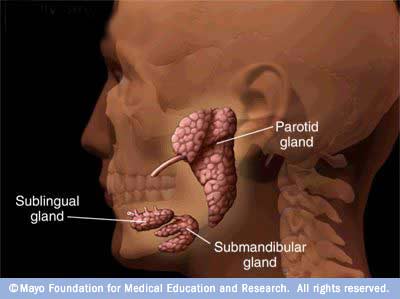If you have less than normal amount of saliva, you are having xerostomia. It is the dryness of the mouth which is a clinical manifestation os salivary gland dysfunction.
Causes:
- Radiation induced
- Ionizing radiation to the head and neck region for the treatment of cancer results in pronounced changes in the salivary glands located within the primary beam.
- The degree of damage caused by the radiotherapy is related to dose-time-volume factor.
- Damage to the acinar cells has been noted with a single rads dose of X-rays
- Radiation sensitivity decreases in the following order : parotid gland, submandibular gland, sublingual to minor glands.
- Serous acinar cells appear to be more sensitive to radiation than the mucus cells.
- As the dose is increased, disorganization and destruction of the acinar cells occur, resulting in their replacement by fibrous or faulty tissues.
- Both the stimulated and unstimulated saliva flow rate decreases dramatically with increasing radiotherapy.
- Pharmacologically induced xerostomia
- There are about 250 drugs which can cause xerostomia. The classes of drugs which cause xerostomia include anticonvulsants, antiemetics, antihistaminics, antihypertensives and antispasmodics
- The mode of action for decreased salivary flow is generally related to the parasympathetic activity.
- Other actions that can decrease salivation are generally more miscellaneous and include vasoconstriction of salivary glands, changes in fluid and electrolyte balance and changes in acinar or ductal function.
- Systemic alternations resulting in xerostomia
- Nutritional deficiency – Pernicious Anemia, Iron Deficiency Anemia, Deficiency of vitamin A and hormones can cause xerostomia.
- Fluid loss associated with hemorrhage, sweating,diarrhea, vomiting and diabetes insipidus can also implicated as causative factors of xerostomia.
- Developemental – Developemental abnormalities of salivary glands, tumors , autoimmune states and certain diseases which affect afferent or efferent portions of neural transmission reflex are some of the causes of xerostomia.
- Systemic diseases, which are accompanied by high temperature and dehydration usually result in diminished salivation
Clinical Features:
- Effect of xerostomia on oral functions
- Increased thirst, increased uptake of fluid especially while eating
- Frequent use of means like chewing gums and consumption of sour candy
- Difficulty in swallowing,speech and eating dry food
- Burning and tingling sensations in the mouth
- Oral infections.Intolerance to dental appliances.Abnormal taste in the mouth
- Painful salivary gland enlargement
- Effect of xerostomia is accompanied by
- Many times xerostomia is accompanied by hypofunction of other secretory glands
- Blurred vision and ocular dryness. Itching, burning and sandy sensation in the eye
- Dryness of the pharynx and skin. Itching and burning sensation of vagina.
- Clinical signs of xerostomia
- Dryness of lining oral mucosa. Oral mucosa appears thin, pale and feels dry
- Tongue blade may adhere to soft tissues.
- Increased incidence of tooth decay
- Candidiasis
- Fissuring and lobulation of the dorsal surface of tongue
- Angular chelitis
Management
Stimulation of salivary production
- Local stimulation – chewing of gums, Â mints, paraffin and citric acid containing lozenges and rinses
Disadvantages are effect are short-term, frequent application can be inconvenient,citric acid may irritate mucosa, continuous use may contribute to demineralization.
- Systemic stimulation – Bromhexine(mucolytic and mucokinetic agent capable of inducing thin copious bronchial secretions) , Anethole trithione (directly acting cholinergic agonist which acts by neurostimulation) , Pilocarpine
Symptomatic treatment
- Salivary substitute – carboxymethylcellulose , hydroxyethyl cellulose as lubricants and variety of artificial sweeteners, preservatives , chloride or fluoride salts.
Disavantages are : Their regular use is inconvenient to the patient.Most of them are more viscous than the natural saliva. They are expensive. They fail to provide anttimicrobial and other protective functions of natural saliva.
Composition of artificial saliva
- Carboxymethylcellulose – 10gm/l
- Sorbitol – 30gm/l
- Potassium chloride – 1.2 gm/l
- Sodium chloride -0.843 gm/l
- Magnesium chloride -0.051 gm/l
- Calcium chloride – 0.146 gm/l
- Dipotassium hydrogen phosphate – 0.342 gm/l
- For dry and cracked lips, water based lubricants are used.
-
Suggestions to the xerostomia patients :
- Try very sweet and tart foods and beverages such as lemonade ; these food may help to produce more saliva.(Do not try this in sensitive teeth)
- Suck on sugar-free hard candy (avoiding those with citric acid), popsicles or chew sugar-free gums. These can help produce more saliva.
- Try sucking ice cubes or ice lollies. Home-made lollies can be easily made by freezing fresh juice in ice-cube trays or in special lolly containers with sticks, which can be bought from many kitchenware shops.
- Avoid chewable vitamin C and acidic, sugared lozenges.
- Use soft and liquid foods, which may be easier to swallow
- Avoid dry foods such as cookies, toast and crackers or soften them with liquids before eating
- Avoid chocolates, peanut butter and pastry: they stick to the roof of the mouth
- Avoid over salty foods.
- Have a sip of water every few minutes to help in swallowing and talking more easily. Carry a small water bottle for frequent sips during the day.
